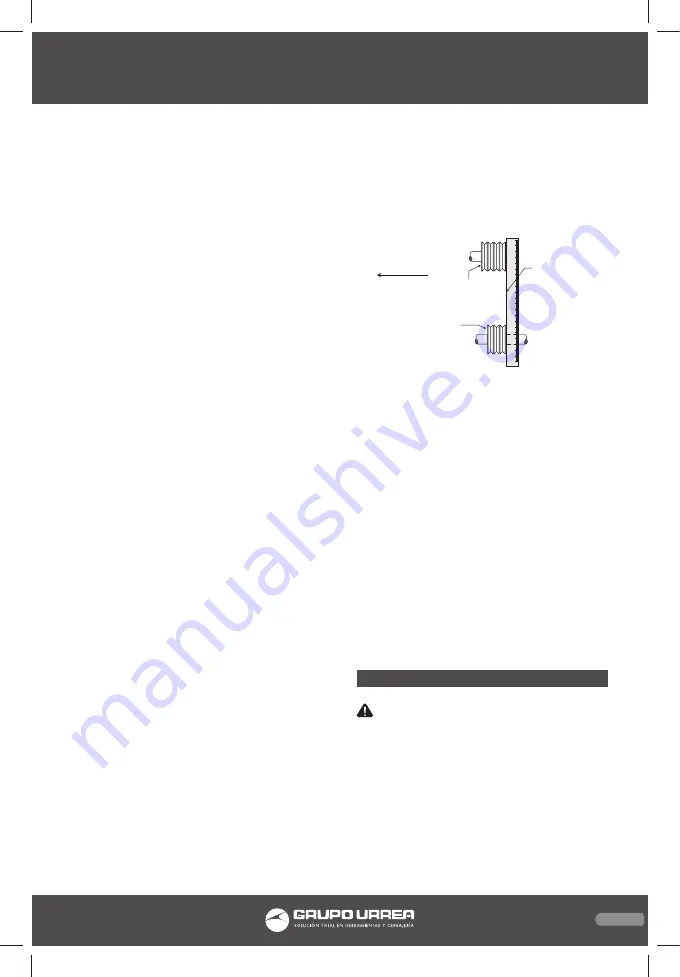
13
E N G L I S H •
User’s manual
3. Step on the left side of PEDAL until hear a
“click”, then turn on the WHEEL HANDLE on the
top of the machine to remove the equipment
forward and reverse, step down the right side of
PEDAL to change to “push” driving system.
4. Lower blade into cut slowly.
5. Cut as fast as blade will allow. If blade climbs
out of cut, reduce forward speed or depth of cut.
6. Use only enough side pressure on cutter han-
dles to follow cutting line.
CUTTING
Lower the blade into concrete to required
depth by turning the tilt crank counterclock-
wise. Ease the saw slowly forward. Slow for-
ward pressure if the saw begins to stall.
NOTE: For deeper cuts (4 inches / 102mm or
more), several cuts should be made in incre-
mental steps of 1-1/2 inch (38 mm) to 2 inches
(51 mm) until the desired depth is reached.
• Push the saw steadily forward using the front
pointer as a guide. Exert enough forward pres-
sure so that the engine/motor begins to labor,
but does not slow down. If the saw begins to
stall, retard forward movement until full RPM
is restored to the blade. If saw stalls, raise the
blade out of the cut before restarting. Avoid
excessive side pressure or twisting of the blade
in the cut.
BELTS & PULLEYS
NEVER MAKE ADJUSTMENTS TO V-BELTS AND
PULLEYS WHILE ENGINE IS RUNNING
1. The best tension for a v-belt drive is the low-
est tension at which the belts will not slip un-
der full load.
2. Take up tension until the belts are snug in
the grooves. Run the drive for about five (5)
minutes to “seat” the belts. The impose the
peak load. If the belts slip, tighten them un-
til they no longer slip at peak load. Most new
belts will need additional tensioning after
seating.
3. Remember, too much tension shortens belt
and bearing life.
4. Check the belt tension frequently during the
first day of operation. Check the belt tension
periodically thereafter and make any necessary
adjustments.
5. The two most common causes of sheave mis-
alignment are:
a) The engine drive shaft and the blade shaft
are not parallel.
b) The pulleys are not located properly on the
shafts.
6. To check alignment, use a steel straight edge.
7. Line up the straight edge along the outside face
of both pulleys shown in the drawing. All pulleys
have 2 set screws in the bottom of their grooves.
Set screws require thread locking lock title.
8. Misalignment will show up as a gap between
the pulley face and straight edge. Make sure
there is clearance between arbor pulley and
saw base on both sides.
DRY CUTTING
• Never operate any saw without safety guards
in place.
• Do not exceed maximum operating speed es-
tablished for blade diameter.
• Do not force blade into material: allow blade
to cut at its own speed.
• Do not make long continuous cuts. Never dry
cut for more than 30 seconds at a time. Allow
blade to cool.
• Do not cut or grind with side of blade or cut
a curve or radius. Do not cut dry with blades
recommended for wet cutting.
• Do not operate saw with blade diameter
larger than machine’s capacity.
MAINTENANCE
CARE AND PREVENTIVE MAINTENANCE
CAUTION: Inspection and other services
should always be carried out on hard and level
ground with the engine shutdown.
· NEVER lubricate components or attempt ser-
vice on a running machine.
· ALWAYS allow the machine a proper amount
of time to cool before servicing.
· Keep the machinery in running condition.
· Fix damage to the machine immediately and
always replace broken parts.
Straight
edge
Engine
pulley
To
engine
Blade
shaft pulley
CCO820 manual.indd 13
17/10/17 10:00






































